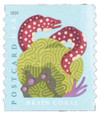
# 5370 - 2019 35c Coral Reefs: Brain Coral (coil)
U.S. #5370
2019 35¢ Coral Reefs – Brain Coral
Despite their name, brain coral do not have brains. Their name comes from their appearance, which is strikingly similar to the human organ. While many living closer to the surface are brightly colored, those that grow in deeper waters are grayer, striking an even stronger reseblance.
Found in most of the world's oceans, brain coral colonies grow six feet or more in height. Most of the brain coral's body is a hard, rock-like skeletal structure. Only a few millimeters on top of the skeleton grow the soft, living polyp tissue. These coral can live up to 900 years, and when the polyps die, new ones grow on the skeleton, adding to its structure. During the day, the polyps wrap tightly around the skeleton. Then at night, they stretch out to collect food. Brain coral also receive nutrients from the algae that live in their tissues.
Brain coral are very resilient and are a species of least concern. They still face threats such as disease and climate change, but they are well adapted to survive harsher conditions.
There are several varieties of brain coral. Some have stinging tentacles that are used against competing coral to catch food. Some are very colorful and others are fluorescent, making them appear to glow when exposed to UV, violet, or blue light. This makes them a popular addition to saltwater aquariums.
U.S. #5370
2019 35¢ Coral Reefs – Brain Coral
Despite their name, brain coral do not have brains. Their name comes from their appearance, which is strikingly similar to the human organ. While many living closer to the surface are brightly colored, those that grow in deeper waters are grayer, striking an even stronger reseblance.
Found in most of the world's oceans, brain coral colonies grow six feet or more in height. Most of the brain coral's body is a hard, rock-like skeletal structure. Only a few millimeters on top of the skeleton grow the soft, living polyp tissue. These coral can live up to 900 years, and when the polyps die, new ones grow on the skeleton, adding to its structure. During the day, the polyps wrap tightly around the skeleton. Then at night, they stretch out to collect food. Brain coral also receive nutrients from the algae that live in their tissues.
Brain coral are very resilient and are a species of least concern. They still face threats such as disease and climate change, but they are well adapted to survive harsher conditions.
There are several varieties of brain coral. Some have stinging tentacles that are used against competing coral to catch food. Some are very colorful and others are fluorescent, making them appear to glow when exposed to UV, violet, or blue light. This makes them a popular addition to saltwater aquariums.









